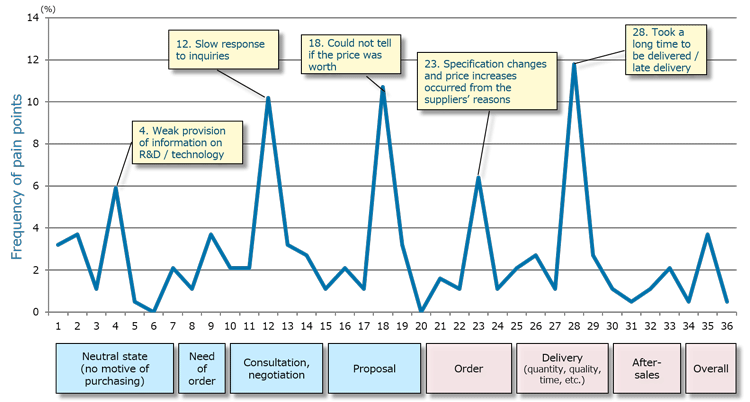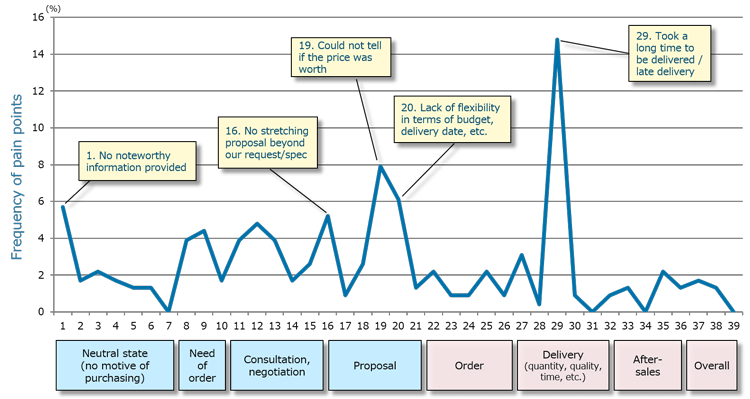BtoB Marketing Updated (1) The Disappointments of Customers are those Unexpected
Amidst drastic changes happening in our business environment, BtoB companies (whose direct customers are organizations and not consumers) also need new business measures. Japanese BtoB companies tend to be “seed-oriented,” but that alone is no longer sufficient enough to push growth and thrive. Where technological capabilities are fundamental, we need marketing that matches the customers and the products and services with a deep understanding of the market from the customers’ aspect. Based on the results of our syndicated survey (conducted in July 2022), we will explain why and how BtoB companies should implement “marketing from the customer's viewpoint.” In this article, we will introduce you to some unexpected “disappointments” that customers find.
You cannot understand your customer from your company's perspective
Today, many companies (both BtoB and BtoC companies) are using the results of customer satisfaction surveys or information received at their customer contact centers to understand they are rated by their customers.
However, most of those are asked and evaluated on “touchpoints considered from the company's viewpoint.”
It can be possible to grasp the customer’s thoughts and use them to “improve” products and services from that information. If you carefully manage the operation with observation and change, you will feel confident in enhancing your business. Breaking down the issues and sending out feedback to each department; planning and development, manufacturing, sales, etc., makes the actions toward improvement at each site more proactive, and it would seem the company is handling well on their service improvement activities rooted in the customer's voice. But the external environment is changing rapidly — with advancing digitalization or the rise of new services and so on. Before you know it, customers’ business environments, purchasing behavior, or business domains could have changed drastically. Thus, it should be getting increasingly difficult to understand the intentions of your customers, just from your point of view. Especially, many BtoB companies are operating globally, and their competitors are also moving fast toward innovation. The competition and differentiation are much more intense than in other business areas.
Revealing dissatisfaction and disappointment from the customer's perspective
To think from the customer's perspective, you need to first identify the “pain points” (negative experiences that customers felt dissatisfied or disappointed) along the customer journey, with VOC (Voice of Customer). Then, review your company's business processes or services where the pain points occur. The key to the first step is to shift from your company's view. This approach is based on a holistic grasp of the customers’ negative or positive experience, the sole understanding of the customers’ behavior. Focusing on the fact (customer experience) that affects the product/service ratings, rather than a direct evaluation of the performance, function, or quality of the product/service itself.
Nikkei Research conducted the survey using this approach. In the following section, we will show you the comparison of the characteristics of two typical BtoB products — (a) Materials: materials, raw materials, and electronic components and (b) Equipment: production process equipment including industrial equipment, measuring and weighing equipment, machine tools, and control equipment.
The “Materials” has many pain points after ordering and upon delivery.

Figure 1 shows the rate of occurrence of “pain points” along the business process (customer journey involving the suppliers) in the “Materials”. Many pain points occurred “after ordering” and “upon delivery.”
The most common problem was “took a long time to be delivered/late delivery.” Companies that purchase “materials, raw materials, and electronic components” use those materials for their products and then supply them to their customers. Therefore, we can assume that they are very much sensitive to experiences that affect their business processes (i.e., delivery time). A recent incident — the global shortage of semiconductors causing supply disruptions for automobiles and other electronics products — shows us why they take it seriously.
Other frequent problems were “could not tell if the price was worth,” “slow response to inquiries,” “specification changes and price increases occurred from the suppliers’ reasons,” and “weak provision of information on R&D/technology.”
In general, after-sales service and customer support are regarded as important customer services. We thought there will be a lot of negative experiences occurring at those touchpoints. However, the survey results showed that is not true, but rather issues existing at touchpoints in a “neutral state” (no motive of purchasing), such as the provision of information.
The “Equipment” has pain points during proposals and sales pitches.

As shown in Figure 2, “took a long time to be delivered/late delivery” was the most frequent problem in the “Equipment” as well, followed by pain points of “could not tell if the price was worth,” “lack of flexibility in terms of budget, delivery date, etc.,” “no noteworthy information provided,” and “no stretching proposal beyond our request/spec.”
Other than the top pain point related to delivery time, many problems occurred during business negotiations to determine suppliers or when detailed proposals were made. The “Equipment” has a significant impact on the quality of products and the efficiency of the production lines. Unlike materials and devices, they cannot be easily changed once installed. From this background, the process of selecting suppliers and deciding on the equipment is crucial.
Don’t whack-a-mole. Be proactive and stay ahead to win new customers.
The above two cases show that pain points occur in different processes depending on the characteristics of each business; before the business negotiations start, when preparing the proposal, after the business negotiation is over, and while building relationships for the next business negotiation.
While companies provide products and services, we can close the gap between the provider's understanding and the customers’ perspective, by grasping the customer's experience.
Instead of doing whack-a-mole in dealing with each complaint when it surfaces, you should build a system that prevents the customer's disappointments from occurring. You should think of measures to improve customer experience, not only for maintaining existing customers but also for acquiring new customers.
| Survey Outline (BtoB CX Survey) | |
|---|---|
| Timing | May 25 (Wed) - June 8 (Wed), 2022 |
| Target audience | Employed by a company (exclude public sectors) Involved in the selection/purchase/use/receiving supports from suppliers as a client-side |
| Focused products |
|
| Number of respondents | 2,532 |
| Methodology | Online survey, recruited from the Nikkei ID research service, fulfilling the above conditions |
please contact us below.

